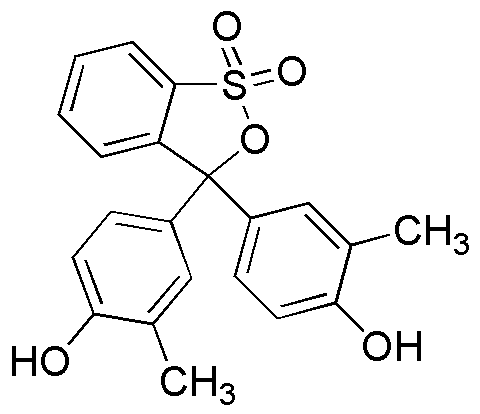Cresol red is widely utilized in research focused on:
- pH Indicator: Commonly used in laboratories to measure pH levels in various solutions, providing a clear color change that helps researchers determine acidity or alkalinity.
- Biological Staining: Employed in histology and microbiology for staining tissues and cells, aiding in the visualization of structures under a microscope.
- Environmental Testing: Used in assessing water quality by indicating the pH of samples, which is crucial for monitoring aquatic ecosystems and ensuring safe drinking water.
- Pharmaceutical Development: Acts as a pH-sensitive dye in drug formulation studies, helping scientists understand how drugs behave in different pH environments, which is vital for effective delivery.
- Educational Purposes: Frequently included in chemistry education to demonstrate acid-base reactions and the concept of pH, making it a valuable tool for teaching students about chemical properties.
Informations générales
Propriétés
Sécurité et réglementation
Applications
Cresol red is widely utilized in research focused on:
- pH Indicator: Commonly used in laboratories to measure pH levels in various solutions, providing a clear color change that helps researchers determine acidity or alkalinity.
- Biological Staining: Employed in histology and microbiology for staining tissues and cells, aiding in the visualization of structures under a microscope.
- Environmental Testing: Used in assessing water quality by indicating the pH of samples, which is crucial for monitoring aquatic ecosystems and ensuring safe drinking water.
- Pharmaceutical Development: Acts as a pH-sensitive dye in drug formulation studies, helping scientists understand how drugs behave in different pH environments, which is vital for effective delivery.
- Educational Purposes: Frequently included in chemistry education to demonstrate acid-base reactions and the concept of pH, making it a valuable tool for teaching students about chemical properties.
Documents
Fiches de données de sécurité (FDS)
La FDS fournit des informations de sécurité complètes sur la manipulation, le stockage et l’élimination du produit.
Spécifications du produit (PS)
Le PS fournit une description complète des propriétés du produit, notamment sa composition chimique, son état physique, sa pureté et les exigences de stockage. Il détaille également les plages de qualité acceptables et les applications prévues du produit.
Certificats d'analyse (COA)
Recherchez des certificats d'analyse (COA) en saisissant le numéro de lot du produit. Les numéros de lot et de lot se trouvent sur l'étiquette d'un produit, après les mots « Lot » ou « Lot de fabrication ».
Numéro de catalogue
Numéro de lot/série
Certificats d'origine (COO)
Ce certificat d'exploitation confirme le pays dans lequel le produit a été fabriqué, et détaille également les matériaux et composants utilisés et s'il est issu de sources naturelles, synthétiques ou autres sources spécifiques. Ce certificat peut être requis pour les douanes, le commerce et la conformité réglementaire.
Numéro de catalogue
Numéro de lot/série
Fiches de données de sécurité (FDS)
La FDS fournit des informations de sécurité complètes sur la manipulation, le stockage et l’élimination du produit.
DownloadSpécifications du produit (PS)
Le PS fournit une description complète des propriétés du produit, notamment sa composition chimique, son état physique, sa pureté et les exigences de stockage. Il détaille également les plages de qualité acceptables et les applications prévues du produit.
DownloadCertificats d'analyse (COA)
Recherchez des certificats d'analyse (COA) en saisissant le numéro de lot du produit. Les numéros de lot et de lot se trouvent sur l'étiquette d'un produit, après les mots « Lot » ou « Lot de fabrication ».
Numéro de catalogue
Numéro de lot/série
Certificats d'origine (COO)
Ce certificat d'exploitation confirme le pays dans lequel le produit a été fabriqué, et détaille également les matériaux et composants utilisés et s'il est issu de sources naturelles, synthétiques ou autres sources spécifiques. Ce certificat peut être requis pour les douanes, le commerce et la conformité réglementaire.


